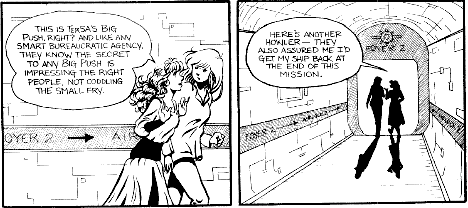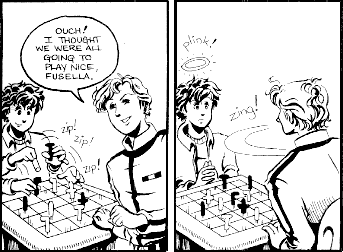Galaxion

![]() According to the editorial notes, the appearance of Galaxion #1 in stores across the continent has been a long time coming. But the timing may be just right. I’m thinking of the fact that Wandering Star, a well-done character-focused black-and-white science-fiction series written and drawn from a female perspective, is about to come to a conclusion. Not a bad point for a new series of a similar description to debut.
According to the editorial notes, the appearance of Galaxion #1 in stores across the continent has been a long time coming. But the timing may be just right. I’m thinking of the fact that Wandering Star, a well-done character-focused black-and-white science-fiction series written and drawn from a female perspective, is about to come to a conclusion. Not a bad point for a new series of a similar description to debut.
 Lest anyone start calling Galaxion “the next Wandering Star“, let me point out that it is not. There’s no big war against aliens here, or beings with non-human powers. (So far, it doesn’t even have aliens in it.) It’s about the fulfillment of the long-time human dream of travelling… not just into space… but to the stars.
Lest anyone start calling Galaxion “the next Wandering Star“, let me point out that it is not. There’s no big war against aliens here, or beings with non-human powers. (So far, it doesn’t even have aliens in it.) It’s about the fulfillment of the long-time human dream of travelling… not just into space… but to the stars.
Those who’ve scooped me on this series (seeing the earlier ashcan, for example) have compared it Star Blazers or Robotech. While the art does have a clear anime/manga influence, the characters are less stylised than is typical of the Japanese comics I’ve seen. I like it, especially because I can tell the characters apart. And best off all, the starship Galaxion doesn’t look like Star Blazers‘ giant space-going submarine. Instead it looks like a giant… well, I think it’s cooler if you see it for yourself. Being an admitted member of the ray-guns-and-hyperdrive set, I spent the first dozen pages of Galaxion #1 wondering what the ship looked like. It was surprising… and oddly pleasant.
One thing Galaxion does share with Wandering Star is a, um, “relaxed” attitude toward science. To avoid spoiling anything from Galaxion #1, I’ll take an example from the historical prolog that appears in the back pages of Thieves & Kings #16. An experimental hyperspace flight fails, leaving the ship stranded a few parsecs from its launching point in orbit around Mars. Their first clue how far they’ve gone is that the star patterns have changed. But the starscape at that distance would look pretty much the same as it does from here, with just a few of the local stars shifting locations noticeably… like, didn’t anyone notice that the sun had dwindled to a bright speck? It also refers to the trip home taking a matter of months “with conventional engines”, instead of the decade (or several) that it would actually take without a visit to hyperspace. <lecture> “Space is big. Really big. You just won’t believe how vastly hugely…” </lecture>
 But this story is clearly one about people (not astrophysics, five-year missions, or galactic warfare), so I ought to get off my astronomy fixation and address that aspect of it as well. Well, that’s where Galaxion shines. The first issue focuses primarily on Aria Schafer, a literate cat-lover and geologist on the still-experimental Galaxion, and her friend Fusella Mierter, the former captain of the Galaxion who has gamely given up command of her ship to a superior officer for a ground-breaking test flight. It also introduces Darvin Deloren and Zandarin Wilder, a couple of good-natured techo-weenies, and General Scavina Nelson, the aforementioned superior officer… whose husband died on the first hyperspace test flight.
But this story is clearly one about people (not astrophysics, five-year missions, or galactic warfare), so I ought to get off my astronomy fixation and address that aspect of it as well. Well, that’s where Galaxion shines. The first issue focuses primarily on Aria Schafer, a literate cat-lover and geologist on the still-experimental Galaxion, and her friend Fusella Mierter, the former captain of the Galaxion who has gamely given up command of her ship to a superior officer for a ground-breaking test flight. It also introduces Darvin Deloren and Zandarin Wilder, a couple of good-natured techo-weenies, and General Scavina Nelson, the aforementioned superior officer… whose husband died on the first hyperspace test flight.
Jenkins promises that this story will have a beginning, middle, and end, which is something that always appeals to me. It increases the chances of interesting things happening and developing as the series progresses. And I look forward seeing where the Galaxion goes from here. I probably won’t be buying this series issue by issue (due to current circumstances and personal preference, I think I’ll wait for collections down the line). But for anyone who wants to be able to brag that they were with it from the beginning (and if quality is recognised, some day you will), hop on board the Galaxion now!
